|
WC vs. History: Grin and Bearcat
The F-104 Bearcat, originally developed as the Cougar, was designed by Douglas Aerospace in the last years of the war as a true space superiority fighter unlike any other in the Confederation's arsenal. Perhaps no other fighter forged in that conflict's inferno better exemplified Michael Casey's ideal of a "true artist's ship." Although at first glance the Bearcat implies a streamlined version of its reliable cousin, the Hellcat, the Bear is a very different machine: a temperamental, high maintenance craft that required an extremely skilled fighter pilot in the cockpit. In an era where multi-role capacity trumped all other aspects, the Bearcat is a rarity--it remains the only "century series" spacecraft not built to double as an attack craft.
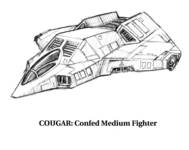 Early sketches for the Bearcat, then called the Cougar.
Early sketches for the Bearcat, then called the Cougar.
But the Bearcat missed the war. No squadrons had entered service by the end of hostilities in 2669. The threat of Bloodfang, Jrathek and Vatari squadrons facing Earth's thin red line had never materialized. In the years that followed Kilrah, ahigh profile space superiority fighter seemed to be of little good to a budget-conscious Confederation concerned more with long-range shipping escort duties and anti-piracy operations. The Bearcat was a man without a country and it seemed one of the finest spaceframes ever constructed was destined for the dustbin of history.
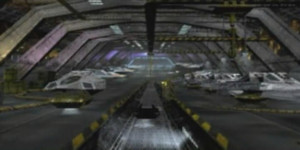 Preparing for war: Bearcat assembly line, Speradon System, 2673.
Preparing for war: Bearcat assembly line, Speradon System, 2673.
Then, came civil war. In 2673, the threat of hostilities between the Confederation and Border Worlds reached a boiling point. Fearing a prolonged guerrilla war with a foe known for their ability to put experienced fighter pilots into space, the Confederation authorized mass production of Bearcats. Construction of new Bearcats began in earnest at Douglas' Speradon factory.
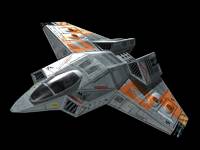 A Bearcat in flight.
A Bearcat in flight.
It may come as a surprise, then, that the main operator of the type was not the Terran Confederation. As the conflict took shape, Union leadership developed a daring plan: an impossible gambit that endangered major forces to smash the Confederation plants at Speradon to slow their industrial power as war broke out. In a coordinated operation, the main body of the Outerworlds Fleet attacked Speradon. The plan was a success: the Border Worlds destroyed factories and drydocks and captured the TCS Princeton, a stock of Mace tactical nuclear missiles and a number of newly built Bearcats. What's more, one of the first Bearcat units currently stationed at Speradon opted to defect to the BWS Tango. As a result, no Bearcat would fly off of Vesuvius--but they would equip multiple squadrons on the Intrepid and other rebel ships.
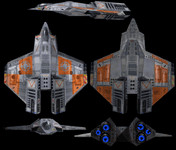 Five-view image of a Bearcat in factory markings.
Five-view image of a Bearcat in factory markings.
In the end, the Bearcat is a minor note in the history. The Border Worlds affair concluded quickly and with limited conflict. With only a taste of intercene conflict, the Bearcat squadrons were relegated to the greatest ignominy a truly capable warbird can suffer: peacetime.
The Grumman F8F Bearcat, much like its Wing Commander relative, missed the war by arriving too late to see combat. Designed to replace the F6F Hellcat onboard US Navy carriers, the Bearcat has been called the pinnacle of piston-engine aircraft design. The performance of the Bearcat, which was actually smaller than the Hellcat, was astounding. The Bearcat was more than capable of performing right alongside early jets. How the Bearcat was able to achieve this all came down to design.
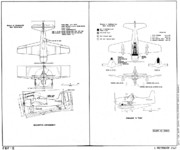 Diagram for F8F-2 Bearcat
Diagram for F8F-2 Bearcat
Like many fighters of the day, the Bearcat was designed around the Pratt & Whitney R-2800 Double Wasp engine. The requirement was to design the smallest possible airframe to mount the engine. The designers wanted a low-weight aircraft that would provide superior performance. They more than got their wish with the Bearcat.
As the F6F Hellcat was making its combat debut in mid-1943 over the South Pacific, the Grumman “Iron Works” received orders to produce the prototype for the F8F. The first prototype flew on 21 August, 1944. The test pilot for the Bearcat was the famous, Corky Meyer, who had and would test many of Grumman’s famous aircraft including the F6F Hellcat, F7F Tigercat, F9F Panther, and the early jet XF10 Jaguar and F11F Tiger.
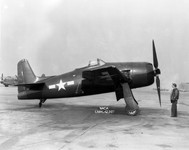 An XF8F-1 prototype, note the size of propeller.
An XF8F-1 prototype, note the size of propeller.
The first Bearcat squadron, VF-19, reached operational status on 21 May, 1945. However, the Bearcat did not see combat before the war ended in September 1945. Yet the lessons of the war were not lost on the designers. The F8F had an improved armament of four 20 mm cannons which gave it greater damage inflicting power.
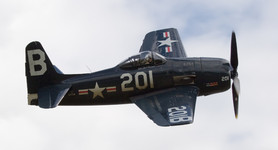
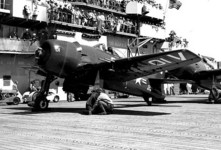 A Bearcat in its element, in flight and on the deck of a US Navy carrier.
A Bearcat in its element, in flight and on the deck of a US Navy carrier.
During the interwar years, the Bearcat became known as one, if not the, best-handling piston-engine fighters ever produced. It was a favorite amongst naval aviators, including future first Man on the Moon Neil Armstrong, who said it was his favorite aircraft. The Navy’s elite Blue Angels flight demonstration team chose the Bearcat as their plane of choice in 1946 because of its impressive aerobatic capabilities. It was with the Bearcat that the Blue Angels developed the famous “Diamond formation” that can still be seen at air shows today.
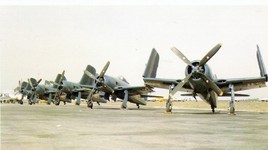 Bearcats in the Blue Angels colors in 1946.
Bearcats in the Blue Angels colors in 1946.
Much like the Rapier II and F-104 Bearcat, the F8F Bearcat was an artist’s ship, however in the case of the F8F it never got to test its mettle in combat.
|

